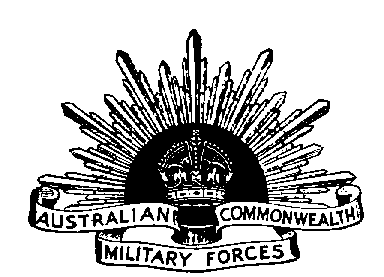


ART00197 Coates, George, Brigadier General Thomas Griffiths (1919), oil on canvas, 127 x 101.5 cm, AWM copyright
Thomas Griffiths was born at Presteigne, Radnor, Wales on 29 September 1865, the son a builder. He was educated at the Old Vicarage, Wrexham, Denbighshire, and migrated to Australia as a young man.
Griffiths enlisted in the Victorian Permanent Artillery as a gunner on 22 July 1886. In 1890 he became a military staff clerk at headquarters in Melbourne. He was promoted to regimental quartermaster sergeant in 1894 and became the chief clerk of the Victorian Military Forces with the rank of warrant officer in 1895. After Federation he became a clerk in the Adjutant General's branch at Army Headquarters in Melbourne. In September 1908 he was appointed secretary to the Military Board with the honorary rank of lieutenant in the Administrative and Instructional Staff. He became an honorary captain on 30 August 1909.
Griffiths was appointed the AIF on 15 August 1914 as a captain on the 1st Division staff. In January 1915, Major General W. T. Bridges appointed Griffiths as his military secretary. On 28 March 1915 he became Deputy Assistant Adjutant General (DAAG) of the 1st Division. He landed at Anzac with the 1st Division Headquarters at around 7:30 am on 25 April 1915. As DAAG, he was responsible for personnel. Most nights he could be found on the Beach and the landing stages, checking and sorting reinforcements, Often this was done under fire. On 12 May 1915, Griffiths became acting Deputy Assistant Adjutant and Quartermaster General (DAA & QMG). As such he was deputy to Lieutenant Colonel C. H. Foott, who was responsible for all administration and logistics in the 1st Division area at Anzac. In June Griffiths, who served at Anzac throughout the campaign, was promoted to major.
When Lieutenant General Sir W. R. Birdwood informally became GOC AIF in October 1915, Griffiths was transferred to his staff, nominally as military secretary, and given responsibility for all matters concerning promotion. In effect, Griffiths became adjutant general of the AIF, and it would be through Griffiths that Birdwood administered the AIF. For his work at Gallipoli and in the reorganisation of the AIF in Egypt, in which he played a major role, Griffiths was mentioned in dispatches and awarded the DSO. In May he was promoted to lieutenant colonel and formally became Assistant Adjutant General of the AIF. Griffiths moved to France with Birdwood's I Anzac Corps Headquarters.
On 8 April 1917, and somewhat against his wish, Griffiths became acting Commandant of the AIF Headquarters in London. He was promoted to full colonel and confirmed in the post on 12 May 1917. As such he was responsible for the entire administration of the AIF, the handling of pay and promotions, the recording of deaths and casualties, the postal services and records. Griffiths was the representative of the Department of the Defence in dealings with the War Office. On 1 January 1918 he became a temporary brigadier general. For his work, Griffiths was mentioned in dispatches in 1916, appointed Companion of St Michael and St George (CMG) in January 1917 and Companion of the British Empire (CBE) in January 1919.
In September 1918, Prime Minister Hughes granted six months leave in Australia to all members of the AIF who had served continuously since 1914. Griffiths elected to take leave, and returned to Australia with the AIF's Director of Medical Services, Major General Sir N. R. Howse, arriving in Sydney on 11 November 1918, the day the war ended. Accordingly, he returned to London in December and resumed duty at AIF Headquarters, finally returning to Melbourne on 4 September 1918.
In March 1920, Griffiths became Inspector General of Administration at the Department of Defence. Then he served as Administrator of New Guinea from April 1920 until March 1921. Later that year he became Administrator of Nauru, a post he held until 1927, when he retired. His retirement was short lived; in 1929 he became head of the Commonwealth War Pensions Entitlement Appeal Tribunal. He returned to New Guinea as Administrator from 1932 to 1934. During World War II he served for a time in the Department of Defence Co-ordination.
He died on 16 November 1947 and was buried with military honours in Melbourne General Cemetery.
General Sir C. B. B. White declared that "No praise can be too high for Griffiths. The administration of nearly a half a million men in war conditions without much guide and precedent, was no mean task and its successful accomplishment was mainly due to Griffiths." A man who knew military procedure, routine and organisation as did few others, Griffiths was one of the great figures of the Australian Army.
Sources: Australian Dictionary of Biography, 1899-1939, Vol 9, pp. 62-63; Bean, C. E. W., The Official History of Australia in the War of 1914-1918. Volume I: The Story of Anzac, p. 79; Volume II: The Story of Anzac, pp. 352, 418; V: The AIF in France 1918, pp. 23-24
Page created by Ross
Mallett
ross@metva.com.au
Last update 8 June 2010